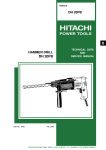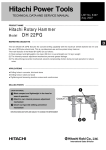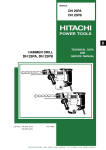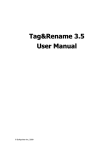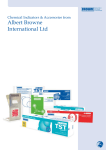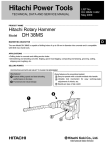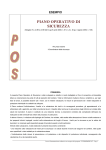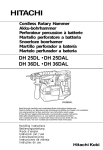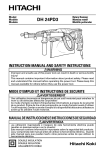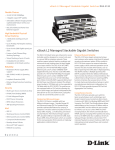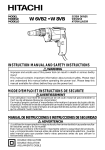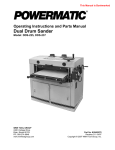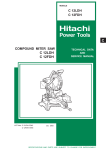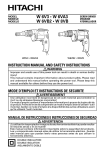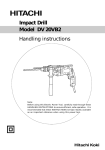Download Hitachi Power Tools
Transcript
MODEL DH 24PC3 Hitachi Power Tools D ROTARY HAMMER DH 24PC3 LIST No. E489 TECHNICAL DATA AND SERVICE MANUAL May 2005 SPECIFICATIONS AND PARTS ARE SUBJECT TO CHANGE FOR IMPROVEMENT REMARK: Throughout this TECHNICAL DATA AND SERVICE MANUAL, symbols are used in the place of company names and model names of our competitors. The symbols utilized here are as follows: Competitors Symbols Utilized Company Name Model Name B BOSCH GBH2-24DSR/N C MAKITA HR2450 CONTENTS Page 1. PRODUCT NAME ............................................................................................................................... 1 2. MARKETING OBJECTIVE ................................................................................................................. 1 3. APPLICATIONS .................................................................................................................................. 1 4. SELLING POINTS .............................................................................................................................. 2 4-1. Selling Point Descriptions .................................................................................................................... 3 5. SPECIFICATIONS .............................................................................................................................. 4 5-1. Specifications ....................................................................................................................................... 4 5-2. Optional Accessories ........................................................................................................................... 5 6. COMPARISONS WITH SIMILAR PRODUCTS ................................................................................. 11 6-1. Specification Comparisons ................................................................................................................ 11 6-2. Drilling Speed Comparison ................................................................................................................ 12 6-3. Chiseling Performance Comparison .................................................................................................. 13 7. PRECAUTIONS IN SALES PROMOTION ....................................................................................... 14 7-1. Handling Instructions ......................................................................................................................... 14 7-2. Caution Plate ..................................................................................................................................... 14 8. REFERENCE MATERIAL ................................................................................................................. 15 8-1. Lubrication ......................................................................................................................................... 15 8-2. Tool Structure ..................................................................................................................................... 15 8-3. "Three-Mode" Changeover Mechanism ............................................................................................ 20 8-4. Drill Bits .............................................................................................................................................. 23 8-5. Chuck Section .................................................................................................................................... 24 8-6. Dust Collector (B) .............................................................................................................................. 24 9. PRECAUTIONS IN DISASSEMBLY AND REASSEMBLY .............................................................. 26 9-1. Disassembly ...................................................................................................................................... 26 9-2. Reassembly ....................................................................................................................................... 30 9-3. Tightening Torque .............................................................................................................................. 33 9-4. Wiring Diagrams ................................................................................................................................ 33 9-5. Internal Wire Arrangement and Wiring Work ..................................................................................... 34 9-6. Insulation Tests .................................................................................................................................. 36 9-7. No-load Current Values ...................................................................................................................... 36 10. STANDARD REPAIR TIME (UNIT) SCHEDULES ......................................................................... 37 Assembly Diagram for DH 24PC3 1. PRODUCT NAME Hitachi Rotary Hammer, Model DH 24PC3 2. MARKETING OBJECTIVE The new Model DH 24PC3 is a 3-mode type rotary hammer based on the Model DH 24PB3 rotary hammer drill. It features the "hammering only" mode that is available for chipping and groove digging in addition to the "rotation + hammering" mode and the "rotation only" mode. The Model DH 24PC3 is equipped with the variable lock mechanism that is available in the "hammering only" mode. With the variable lock mechanism, the tip angle of a cold chisel or other tool is selectable from 36 levels. The main features of the Model DH 24PC3 are as follows: (1) Class-top drilling speed (2) More comfortable and frisky drilling (3) Long service life and high durability thanks to the internal pressure adjustment mechanism (4) Non-slip double-layer molded handle and gear cover (5) New and powerful design aiming at iF design award 3. APPLICATIONS (1) Rotation and hammering function Drilling anchor holes Drilling holes in concrete, tile, brick and similar materials (2) Rotation only function Drilling holes in steel and wood (with chuck adapter) Tightening and loosening machine screws and wood screws (with chuck adapter) (3) Hammering only function Light-duty chiselling of concrete Groove digging and edging [Typical applications] Air conditioning ................................... Installation of air conditioners, water coolers and heaters, and air ducts Piping and plumbing ........................... Installation of gas, water, and sanitary facilities Electrical work ..................................... Installation of light fixtures and various electric appliances Interior decoration ............................... Installation of seating , display stands and partitions Other civil engineering, construction and repair work --- 1 --- 4. SELLING POINTS Class-top drilling speed More comfortable and frisky drilling New and powerful design Compact body Non-slip double-layer molded gear cover Non-slip double-layer molded handle Internal pressure adjustment mechanism --- 2 --- 4-1. Selling Point Descriptions 4-1-1. Selectable from 3 modes, "rotation + hammering", "rotation only" and "hammering only" The new Model DH 24PC3 is a 3-mode type rotary hammer based on the Model DH 24PB3 rotary hammer drill (2-mode type). It features the "hammering only" mode in addition to the "rotation + hammering" mode and the "rotation only" mode. The "hammering only" mode is available not only for light-duty chipping by means of bull points but also for groove digging and edging by means of cold chisels and cutters for various applications. 4-1-2. Variable lock mechanism With the variable lock mechanism, the tip angle of a tool such as a cold chisel or a cutter is selectable from 36 levels and can be locked in the "hammering only" mode. Thus the tip of a tool can be properly positioned according to the application. 4-1-3. Class-top drilling speed The drilling speed of the Model DH 24PC3 is 1.4 times higher than B and 1.2 times higher than C thanks to the efficient transmission of the hammering energy. 4-1-4. More comfortable and frisky drilling The Model DH 24PC3 can drill holes more comfortably and friskily with a light pushing force because the quantity of body jumping is 20% less than C. 4-1-5. Internal pressure adjustment mechanism By minimizing variations in the internal pressure during operation, hammering operation is stabilized. In addition, idling and grease leakage can be prevented. 4-1-6. Non-slip double-layer molded gear cover The double-layer molded gear cover consists of a plastic resin base covered with a soft resin to ensure ease of operation and a non-slip grip during chipping. 4-1-7. Non-slip double-layer molded handle The double-layer molded handle consists of a plastic resin base covered with a soft resin to ensure a soft-touch and non-slip grip. 4-1-8. Compact body: Entire length 351 mm The Model DH 24PC3 has the same helical driving structure as the Model DH 24PC2 to make the entire length as short as possible to 351 mm. The Model DH 24PC3 has the shortest body in the class. Maker/Model Entire length (mm) HITACHI DH 24PC3 351 B 360 C 360 --- 3 --- 5. SPECIFICATIONS 5-1. Specifications Model Capacity DH 24PC3 Concrete 3.4 --- 24 mm (1/8" --- 15/16") Steel 13 mm (1/2") Wood 32 mm (1-1/4") Power source AC single phase 50 Hz or 60 Hz Voltage, current and power input Voltage (V) 110 120 220 230 240 Current (A) 7.6 7.0 3.8 3.6 3.5 Power input (W) Rotation speed 800 No-load Forward: 0 to 1,150 min-1, Reverse: 0 to 550 min-1 Full-load 0 to 890 min-1 Full-load blow rate 0 to 4,600 min-1 Type of motor Type of switch AC single-phase commutator motor Speed control switch with reversing switch Type of handle Gun-type handle of main body and side handle Enclosure Housing Handle cover Gear cover ••• • • • • • • • • • • • Weight Net* 2.4 kg (5.3 lbs.) Gross 4.5 kg (9.9 lbs.) Packaging Plastic case Standard accessories (1) Plastic case Glassfiber reinforced polyamide resin (green and black) Glassfiber reinforced polyamide resin (cool gray and black) ••••••••••••••••••••••••••••••••••••••••••••••••••••••••••••••••••••••••••••••••••••••• (2) Side handle (3) Depth gauge ••••••••••••••••••••••••••••••••••••••••••••••••••••••••••••••••••••••••••••••••••••••• •••••••••••••••••••••••••••••••••••••••••••••••••••••••••••••••••••••••••••••••••••••• *: Weight excludes cord and side handle. --- 4 --- 1 1 1 5-2. Optional Accessories A. Drilling anchor holes (rotation + hammering) Drill bit (slender shaft) (2) Adapter for slender shaft (SDS-plus shank) (1) Drill bit (slender shaft) Drill bit (slender shaft) Outer dia. (mm) Adapter for slender shaft Effective length (mm) Overall length (mm) Code No. Code No. 3.4 (1/8") 45 (1-25/32") 90 (3-17/32") 306369 3.5 (9/64") 45 (1-25/32") 90 (3-17/32") 306368 306370 Drill bit (taper shank) (3) Cotter (2) Taper shank adapter (SDS-plus shank) (1) Drill bit (taper shank) (2) Taper shank adapter (1) Drill bit (Taper shank) (3) Cotter Outer dia. (mm) Code No. Type Code No. 11 (7/16") 12.3 (31/64") 12.7 (1/2") 14.3 (9/16") 14.5 (73/128") 17.5 (11/16") 944460 944461 993038 944462 944500 944463 Morse taper No. 1 303617 21.5 (27/32") 944464 Morse taper No. 2 303618 Part name Code No. A-taper 303619 B-taper 303620 Code No. 944477 Taper shank adapters (A-taper or B-taper) is provided as an optional accessory, but drill bit is not provided. 13 mm hammer drill chuck For drilling operations when using a straight shank bit for impact drilling with a rotary hammer Straight-shank bit for impact drills 13 mm (1/2") hammer drill chuck (SDS-plus shank) Part name 13 mm (1/2") hammer drill chuck (Including chuck wrench) Code No. 303332 Chuck wrench 303334 Rubber cap 303335 --- 5 --- Chuck wrench B. Anchor setting (hammering only) Anchor setting bar to permit anchor setting operation with the rotary hammer Anchor setting bar Anchor setting adapter (SDS-plus shank) Part name Part name Overall length Code No. W-1/4 Anchor setting adapter-A W-5/16 Anchor setting adapter-A W-3/8 Anchor setting adapter-A W-3/8 Anchor setting adapter-A 302976 302975 303621 302974 260 260 160 260 Overall length Code No. W-1/4 Anchor setting adapter-B W-5/16 Anchor setting adapter-B W-3/8 Anchor setting adapter-B W-3/8 Anchor setting adapter-B 260 260 160 260 External cone type Internal cone type Anchor setting bar for manual anchor setting Anchor setting adapter Part name W-1/4 Anchor setting adapter-A W-5/16 Anchor setting adapter-A W-3/8 Anchor setting adapter-A W-1/2 Anchor setting adapter-A W-5/8 Anchor setting adapter-A Code No. Part name Code No. 971794 971795 971796 971797 971798 W-1/4 Anchor setting adapter-B W-5/16 Anchor setting adapter-B W-3/8 Anchor setting adapter-B W-1/2 Anchor setting adapter-B W-5/8 Anchor setting adapter-B 971799 971800 971801 971802 971803 Internal cone type External cone type C. Large hole boring (rotation + hammering) Center pin, core bit, core bit shank and guide plate (Guide plate) Center pin Core bit Core bit shank (SDS-plus shank) (1) Center pin (Do not use bit with outer diameter of 25 mm (31/32") and 29 mm (1-5/32") Center pin (A) Core bit (outer diameter) 32, 35, 38 mm (1-1/4", 1-3/8", 1-1/2") Code No. 982684 Center pin (B) Core bit (outer diameter) 45, 50 mm (1-25/32", 2") --- 6 --- Code No. 982685 302979 302978 303622 302977 (2) Guide plate Core bit (outer diameter ) (mm) Code No. 32 (1-1/4") 982686 35 (1-3/8") 982687 38 (1-1/2") 982688 45 (1-25/32") 982689 Core bit (outer diameter ) (mm) 50 (2") Code No. 982690 (3) Core bit with guide plate (The guide plate is not supplied with 25 mm (31/32") and 29 mm (1-5/32") outer diameter core bits.) Outer diameter (mm) Code No. Outer diameter (mm) 25 (31/32") 982672 45 (1-25/32") 982677 29 (5/32") 982673 50 (2") 982678 32 (1-1/4") 982674 35 (1-3/8") 982675 38 (1-1/2") 982676 Code No. (4) Core bit shank (SDS-plus shank) Core bit shank (A) Code No. 303625 Core bit (outer diameter) 25 --- 38 mm Overall length 105 mm (4-1/8") (31/32" --- 1-1/2") Overall length 300 mm (11-52/64") Code No. 303626 Core bit shank (B) Core bit (outer diameter) 45 --- 50 mm Overall length 300 mm (11-52/64") Code No. 303627 (1-25/32" --- 2") D. Bolt placing operations with chemical anchor (rotation + hammering) (Standard sockets available on the market) 12.7 mm (1/2") Chemical anchor adapter (SDS-plus shank) 19 mm (3/4") Chemical anchor adapter (SDS-plus shank) Part name Code No. 12.7 mm (1/2") Chemical anchor adapter 303044 19 mm 303045 (3/4") Chemical anchor adapter E. Crushing operations (hammering only) Bull point (round type) (SDS-plus shank) Code No. 303046 Square bull point (SDS-plus shank) Code No. 316656 --- 7 --- F. Groove digging and edging (hammering only) Cold chisel (SDS-plus chank) Code No. 316657 Cutter (SDS-plus shank) Code No. 316658 G. Grooving (hammering only) Grooving chisel (SDS-plus shank) Code No. 316659 --- 8 --- H. Drilling hole and driving screws (rotation only) Drill chuck, chuck adapter (G), special screw and chuck wrench 13 mm (1/2") Drill chuck (13VLRB-D) Special screw Chuck wrench Chuck adapter (G) (SDS-plus shank) (Note) If the tool is to be used for loosening screws, open the three jaws of the drill chuck and securely fix the drill chuck to chuck adapter (G) with the special screw (a left-hand threaded M6 screw) when mounting the drill chuck onto chuck adapter (G). Code No. Part name a. Chuck adapter (G) for SDS-plus shank system 303623 b. 13 mm (1/2") Drill chuck 13VLRB-D (with chuck wrench) 321814 c. Special screw (M6 left-hand threaded) 981122 (2) Slotted-head (minus) bit (1) Cross-recessed head (Phillips) bit [Overall length: 70 mm] [Overall length: 50 mm] (For use with cross-recessed head (Phillips) screw) (For use with slotted-head (minus) screw) Tip thickness Stamped bit No. Bit No. Code No. Applicable screw dia. (mm) Bit tip thickness Code No. Applicable screw dia. (mm) No. 2 955654 4 --- 5 0.8 955658 4 No. 3 955655 6 --- 8 1 955673 5 --- 6 --- 9 --- I. Driling hole (rotation only) For drilling holes in steel and wood ••• Chuck adapter (D) (SDS-plus shank) Drill chuck (13VLD-D) Chuck wrench (NOTE) The 13VLD-D drill chuck and chuck adapter (D) cannot be used for reverse rotaion. If reverse rotation is to be used for loosening screws, use the plus bit (Bit No. 2) described below by attaching it directly to chuck adapter (D). Part name Code No. Chuck adapter (D) (for SDS-plus shank type) 303624 13 mm (1/2") Drill chuck 13VLD-D (with chuck wrench) 321813 J. Drilling screws (rotation only) Plus driver bit [overall length: 25 mm] (for cross-recessed head screws) + Bit No. Chuck adapter (D) (SDS-plus shank) K. Grease for electric impact drill Containing 500 g (17.64 oz): Code No. 980927 Containing 30 g (1.06 oz): Code No. 981840 70 g (2.5 oz): Code No. 308471 L. Dust cup, dust collector (B) Dust cup Code No. 971787 Dust collector (B) ass'y Code No. 306885 --- 10 --- Bit No. Screw size Code No. No. 2 3 --- 5 mm No. 3 6 --- 8 mm 971511Z 971512Z 6. COMPARISONS WITH SIMILAR PRODUCTS 6-1. Specification Comparisons Maker • Model Item Capacity HITACHI DH 24PC2 B C Concrete mm 24 (15/16") 24 (15/16") 24 (15/16") 24 (15/16") Steel mm 13 (1/2") 13 (1/2") 13 (1/2") 13 (1/2") Wood mm 32 (1-1/4") 32 (1-1/4") 32 (1-1/4") 32 (1-1/4") W 800 720 680 780 -1 0 --- 1,150 0 --- 1,150 0 --- 870 0 --- 1,100 -1 0 --- 4,600 0 --- 4,600 0 --- 4,400 0 --- 4,500 kg 2.4 (5.3 lbs.) 2.5 (5.5 lbs.) 2.4 (5.3 lbs.) 2.4 (5.3 lbs.) Length mm 351 (13-13/16") 351 (13-13/16") 360 (14-3/16") 360 (14-3/16") Height mm 198 (7-51/64") 198 (7-51/64") 205 (8-1/16") 197 (7-3/4") Width mm 78 (3-1/16") 69 (2-23/32") 84 (3-5/16") 76 (3") (Lever-type) (Lever-type) Input No-load rotation speed Full-load impact rate min min Weight Dimension HITACHI DH 24PC3 Forward-reverse changeover switch (Push-button type) (Push-button type) Tool retainer Function One-push type One-push type One-push type One-push type 3 modes 3 modes 3 modes 3 modes Double-layer molded handle Changeover modes Note 1) Mark " ": Equipped Mark " ": Not equipped 2) Weight excludes cord and side handle. --- 11 --- 6-2. Drilling Speed Comparison Drilling speed varies considerably depending on the work conditions. Use the factory test results shown in Fig. 1 for comparison purpose only. 800.0 HITACHI DH 24PC3 700.0 B C 600.0 Drilling speed (mm/min.) HITACHI DH 24PC2 500.0 400.0 300.0 200.0 100.0 0.0 6 8 10 12 14 16 18 20 22 24 Drill bit dia. (mm) Fig. 1 [Test conditions] Direction Pushing force Test material : Downward drilling : 98 N (10 kgf) : Concrete panel with a compression strength of 2,352 N/cm2 (240 kgf/cm2) --- 12 --- 6-3. Chiseling Performance Comparison Chiseling performance varies considerably depending on the work conditions. Use the factory test results shown in Fig. 2 for comparison purposes only. Voltage supply Chiseling amount (kg/30 min.) Model Maker 0 HITACHI 5 10 15 20 25 30 32 DH 24PC3 HITACHI 35 31 DH 24PC2 230 V B 20 C 27 Fig. 2 --- 13 --- 7. PRECAUTIONS IN SALES PROMOTION In the interest of promoting the safest and most efficient use of the Model DH 24PC3 Rotary Hammer by all of our customers, it is very important that at the time of sale the salesperson carefully ensures that the buyer seriously recognizes the importance of the contents of the Handling Instructions, and fully understands the meaning of the precautions listed on the Caution Plate attached to each tool. 7-1. Handling Instructions Although every effort is made in each step of design, manufacture and inspection to provide protection against safety hazards, the dangers inherent in the use of any electric power tool cannot be completely eliminated. Accordingly, general precautions and suggestions for the use of electric power tools, and specific precautions and suggestions for the use of the Rotary Hammer are listed in the Handling Instructions to enhance the safe, efficient use of the tool by the customer. Salespersons must be thoroughly familiar with the contents of the Handling Instructions to be able to offer appropriate guidance to the customer during sales promotion. 7-2. Caution Plate The Model DH 24PC3 unit is provided with a Caution Plate (illustrated below) which lists basic safety precautions in use. Carefully ensure that the customer fully understands and follows these precautions before using tool. For Australia and New Zealand For the U.S.A. and Canada --- 14 --- 8. REFERENCE MATERIAL 8-1. Lubrication It is not necessary to replenish the grease lubricant unless the tool is disassembled or there is grease leakage due to a defective seal. Special grease is used in the striking section. Should the striking section (within the gear cover) be disassembled, carefully remove the old grease from all parts and, on reassembly, inject 45 g (1.6 oz) of new grease into the gear cover and 5 g (0.2 oz) into the groove of the inner cover. Be careful not to exceed the designated amount of grease. Excessive grease will reduce striking efficiency. Apply Molub Alloy No. 777-1 grease to the pin portion of the change lever. 8-2. Tool Structure Transmission of rotation Unlike conventional hammer drills, the armature shaft in the Model DH 24PC3 is in parallel with the tool shaft the same structure that is employed in most impact drills. This structure was adopted in order to make the Model DH 24PC3 more compact for easier handling and operation. Thus, the appearance of the Model DH 24PC3 is similar to that of an impact drill. The rotation of the armature is transmitted to the second shaft via the first gear, and causes it to rotate. The second pinion provided on the second shaft engages the second gear mounted on the outer circumference of the cylinder. The cylinder is coupled to the second gear by means of a slip mechanism, and they rotate together. The end of the cylinder also functions as the drill bit retainer. The cylinder is key-connected to the inserted drill bit by means of two key rails, and transmits rotation to the drill bit. A steel ball is used to prevent the bit from coming off. --- 15 --- Piston reciprocating mechanism In conventional rotary hammers, a piston is caused to reciprocate by a connecting rod and crank shaft, and the crank shaft and the cylinder axes are at right angles to each other. Accordingly, the armature shaft and the cylinder axes are also at right angles to each other. In the Model DH 24PC3, through adoption of a spiral drive system (a mechanism using a reciprocating bearing), a more compact design has been achieved by arranging the armature shaft in parallel with the cylinder axis. Referring to Fig. 3, the armature's rotation is transmitted to the second shaft via the first gear. The second shaft's rotation is then transmitted through a spline to the clutch, which engages with a reciprocating bearing and causes it to rotate. However, as illustrated, circular grooves on the inner race of the reciprocating bearing are positioned on an angle of inclination with relation to the second shaft. The rotation of the inner race and the shaft causes the angle of inclination to change regularly forward and back with relation to the second shaft, and produces a rocking motion in the outer race of the reciprocating bearing. Finally, a rod extending from the outer race of the reciprocating bearing is connected to the piston by a piston pin, and causes the reciprocating motion of the piston. Armature Piston pin Piston Second gear Steel ball Tool shaft Motor shaft Cylinder Second shaft First gear Clutch Reciprocating bearing Ring groove Fig. 3 --- 16 --- Key rail (2 pcs.) Hammering function The piston reciprocates within the cylinder to move the striker in the same manner as in conventional rotary hammers. As the piston reciprocates, the changing air pressure inside the air chamber between the piston and the striker causes the striker to move and repeatedly strike against the end of the second hammer. At the same time, the changing air pressure within the air chamber which moves the striker also provides an "air cushion" which absorbs the impact of the hammering action. As any air leakage from the air chamber weakens the air-cushion effect and reduces impact absorption, the O-ring (mounted on the striker) is extremely important to seal the air. Although a special rubber material is utilized in construction of the O-ring to make its effective service life as long as possible, wear cannot be fully avoided. Accordingly, it is recommended that the O-ring be replaced approximately once a year, depending on the frequency of usage of the tool. Idle hammering prevention mechanism The idle hammering prevention mechanism in the Model DH 24PC3 is different from that of conventional rotary hammers. When the drill bit is lifted from the work surface on completion of drilling, the second hammer moves to the position indicated by the continuous lines in Fig. 4 and the protruding (lip) portion at the tip of the striker is gripped by O-ring (C) mounted between the hammer holder and the damper holder. In this state, should the piston continue to move so that the small piston vent hole is blocked by the inner wall of the cylinder, the air in the air chamber will pass through the large piston vent hole and be released through the airescape slot and large cylinder vent hole provided on the inner wall of the cylinder. Accordingly, there is no change in the air pressure within the air chamber, and movement of the striker (idle hammering operation) is prevented. The gripping force of O-ring (C) on the striker is so small in comparison with the conventional mouth system that practically no pressing force at all is required to restart the hammering operation. Striker Air-escape slot Small piston vent hole Gear cover Large piston vent hole Second gear Piston Moving distance Front cap Air chamber Claw Cylinder Second hammer O-ring (C) Coil spring First gear Reciprocating bearing Clutch claw Fig. 4 --- 17 --- Slip mechanism The slip mechanism in the Model DH 24PC3 consists of a coil spring which applies a pre-set amount of pressure to ensure the interlocking of three claws provided on the flange of the cylinder (the final rotating shaft) and six matching claws provided on the face of the second gear, by which rotation is transmitted to the cylinder. The second gear is fitted to the cylinder with a certain amount of play. If an excessively large torque is applied to the tool shaft (cylinder), the force of the torque will exceed the pressure of the coil spring and cause the claws on the second gear to disengage from and ride over the claws on the cylinder so that the second gear idles and does not transmit rotation. Even if the drill bit comes in contact with a reinforcing bar within the concrete, causing sudden excessive torque, the slip mechanism functions to prevent damage to the gears, and possible loss of control of the tool by the operator. Sealed and dustproof construction The gear cover is totally enclosed by oil seals, O-rings and other devices to prevent leakage of lubricating grease, and to keep dust and dirt out of the internal mechanisms. The drill bit chuck portion is protected by a rubber front cap to keep out dust and chips which could cause improper fitting of the drill bit and/or other faulty operation of the chuck portion. The speed control switch is also a fully dust-proofed type to prevent dust and chips from entering the handle section and causing possible operational trouble or a break down of the insulation. Speed control The Model DH 24PC3 is equipped with a variable speed control switch which permits free change of the rotation speed and hamemring force. When drilling in fragile materials, pull the switch trigger gently for low rotation speed (hammering force) to achieve optimum results. Note that the switch trigger cannot be pulled to the full but up to the half in the reverse drilling, and the speed is about half of the forward drilling. In addition, the switch stopper cannot be used in the reverse drilling. --- 18 --- Internal pressure adjustment mechanism An air passage is provided as shown in Fig. 5 to let out air inside the gear cover and let outside air in the gear cover. This passage is sandwiched between felt packings to pass only air (pressure). Thus variations in the internal pressure are minimized for stable hammering operation and prevention of idling and grease leakage. A-A (2:1) Air passage (Outside the gear cover) (Inside the gear cover) Felt packing (B) Valve Felt packing (A) Inner cover Fig. 5 --- 19 --- 8-3. "Three-Mode" Changeover Mechanism The change lever of the Model DH 24PC3 permits quick and easy changeover among the "rotation and hammering", "rotation only" and "hammering only" functions. Each function mode is explained below. When operating the change lever, be sure to continue pressing the pushing button. (1) Rotation and hammering (Fig. 6) Adjust the change lever to "rotation and hammering" ( marks). Armature rotation is transmitted to the first gear and second shaft, and then to the clutch via the spline of the second shaft. Claws on the end surface of the clutch engage with matching claws of the reciprocating bearing ( A portion in the figure) to convert the rotation into reciprocating motion. Three claws on the tip of the second shaft engage with matching three claws of the pinion sleeve all the time, and the second shaft rotation is transmitted to the pinion sleeve. Then claws on the large-dia. portion of pinion sleeve engage with the second pinion ( B portion in the figure), and the rotation is transmitted to the second gear and the cylinder. Second gear Armature Cylinder Pinion sleeve Theree claws of second shaft First gear Reciprocating bearing Second shaft A portion is meshed (hammering transmitted). Change lever Spline of the second shaft Clutch Fig. 6 --- 20 --- B portion is engaged. (rotation transmitted). Second pinion (2) Rotation only (Fig. 7) Adjust the change lever to "rotation only" ( mark). The lock plate is moved forward by the pin of the change lever, and the clutch is moved forward at the back end of the lock plate. Engagement between the clutch and the claws of the reciprocating bearing is released ( A portion in the figure). Thus no rotation is transmitted to the reciprocating bearing and hammering is stopped. On the other hand, the pinion sleeve engages with the second pinion ( B portion in the figure), and so the rotation is transmitted to the pinion sleeve for "rotation only" function. Claw of reciprocating bearing A portion is separated (hammering stopped). Clutch claw Reciprocating bearing Second pinion Pinion sleeve Lock plate (rear end portion) Change lever pin Lock plate (front end portion) Fig. 7 B portion is meshed (rotation transmitted). (3) Hammering only (Fig. 8) Adjust the change lever to "hammering only" ( mark). The second pinion is moved to the motor side by the pin of the change lever. Engagement between the pinion sleeve and the second pinion is released and no rotation is transmitted ( B portion in the figure). The lock plate is moved to the motor side by spring (B) and engaged with the locking claw of the second pinion to lock the cylinder rotation ( C portion in the figure). On the other hand, the clutch engages with the reciprocating bearing for "hammering only" function ( A portion in the figure). C portion meshed (tool locked). A portion is meshed (rotation transmitted). Locking claw of second pinion Lock plate Second pinion Second gear Cylinder Pinion sleeve Clutch Reciprocating bearing Change lever pin Fig. 8 --- 21 --- Spring (B) B portion is separated (rotation stopped). (4) Neutral (Fig. 9) The Model DH 24PC3 has a neutral mode used for positioning a tool such as a flat chisel. Adjust the change lever to a position halfway between "hammering only" ( mark) and "rotation and hammering" ( marks). Engagement between the pinion sleeve and the second pinion ( B portion in the figure), and between the lock plate and the locking claw of the second pinion ( C portion in the figure) is released and the cylinder rotates freely. Simply turn the grip to adjust the tool to the desired position. C portion is separated (tool turns free). Lock plate Second pinion Locking claw of second pinion Second gear Cylinder Pinion sleeve B portion is separated (rotation stopped). Fig. 9 --- 22 --- 8-4. Drill Bits The chuck section is designed exclusively for the popular and widely available SDS-plus shank bits, as shown in Fig. 10. Rotating torque is transmitted to the drill bit by two key rails provided in the tool holding section. A steel ball is used to prevent the bit from coming off. Key slot (two pieces) A Section A - A' A' Shape of SDS-plus shank bit Key rail (2 pcs.) Cylinder Ball holder Steel ball Chuck section Fig. 10 The service life of a drill bit with a diameter of 8 mm is approximately 300 holes when drilling into concrete to a depth of 30 mm. If reground before the end of its service life, the drill bit will continue to provide efficient drilling. Figure 11 shows the regrinding angle. Rotation direction Regrinding angle of drill bit a:b = 1:2 Section A - B 130û Fig. 11 --- 23 --- 8-5. Chuck Section The tool retainer is structured as shown in Fig. 12. The tip of the tool retainer is covered with the front cap (made of rubber) to prevent dust and chips from getting inside. The steel ball falls into the round groove of the bit to prevent the tool from coming off and the two key rails transmit the rotation torque. To mount the bit, push the bit in the tool retainer as far as it will go. Pushing lightly, turn the bit until it is caught. At this position, push the bit in as far as it will go (sliding the grip is not required for mounting the bit). To remove the bit, slide the grip backward to the full and remove the bit. Grip Holder spring Ball holder Washer (B) Steel ball Front cap Stopper ring Cylinder Key rail (2 pcs.) Holder plate Fig. 12 8-6. Dust Collector (B) When drilling holes overhead, dust collector (B) can be mounted on the Model DH 24PC3 to prevent dust and chips from falling downward. Dust collector (B) is intended solely for use when drilling holes in concrete, and cannot be used for drilling holes in steel or wood. It is designed for use with drill bits with overall lengths of 110 mm, 160 mm and 166 mm, and cannot be used with any longer bits. When using a drill bit with an overall length of 166 mm with dust collector (B), drilling up to a depth of approximately 72 mm is possible. When using dust collector (B), ensure it is securely fastened to the grip on the main body with socket adapter (B). Although the socket and socket adapter (B) rotate together with the tool shank, there is a steel ball between the outer race and the socket which serves as a ball bearing. Should the dust cover be forced against the concrete surface, it will not rotate even though the tool shank continues to rotate. Should the tool be operated when the dust cover is not being held against a concrete surface, inertia may cause dust collector (B) to become disconnected from the grip. Accordingly, caution the customer to press dust collector (B) and drill bit firmly against the concrete surface before turning on the switch to start drilling. When dust collector (B) is used, almost no dust and chips are scattered about. However, since the chips and dust remaining in the collector may scatter after completion of the drilling operation, the customer should be advised to always wear protective glasses. When dust collector (B) is disassembled for repair of maintenance, be very careful to prevent oil or grease from adhering to the steel balls. Grease or oil on the steel balls may cause concrete dust to enter the unit and cause defective rotation. --- 24 --- Approx. 72 mm (2-27/32") Approx. 16 mm (5/8") Grip (on the main body side) Drill bit length = 166 mm Drill bit length = 110 mm Socket adapter (B) Seal cover Dust cover Socket Retaining ring for D30 shaft Outer race Washer Steel Ball D6.35 Fig. 13 Dust collector (B) structure --- 25 --- 9. PRECAUTIONS IN DISASSEMBLY AND REASSEMBLY The [Bold] numbers in the descriptions below correspond to the item numbers in the Parts List and exploded assembly diagram. 9-1. Disassembly (1) Disassembly of the striking mechanism section Push the Second Hammer [29] in the main body with a drill bit or screwdriver to release the Striker [37] from O-ring (C) [34]. Pressing the Pushing Button [18], move the Change Lever [21] to the "hammering only" mode ( mark). (Be sure to keep pressing the Pushing Button [18] when operating the Change Lever [21].) Loosen the four Tapping Screws (W/Flange) D5 x 35 [9], and remove the Gear Cover Ass'y [10]. The Inner Cover Ass'y [41] and the Housing [68] are loosely fitted together. Attempting to pull them out first could cause the Armature [62] to be pulled out at the same time, causing damage to the Carbon Brushes (Auto Stop Type) [74]. Remove Spring (B) [22] from the rails in the Gear Cover Ass'y [10] as shown in Fig. 14. Pull out the Second Pinion [49], Clutch Spring [50], Clutch [51] and the Lock Plate [48] (these parts are sandwiched by means of the Lock Plate [48] as a unit as shown in Fig. 15) from the end of the Second Shaft [52]. Turn the Reciprocating Bearing [53] so that the Piston [39] is moved to its maximum upper position (Inner Cover Ass'y [41] side). The arm of the Reciprocating Bearing [53] can then be disconnected from the Piston Pin [42], and the Second Shaft [52] and the components mounted on it can be removed from the Inner Cover Ass'y [41] as a unit. Remove the First Gear [54] from the Second Shaft [52] with a bearing puller. Then take off the Reciprocating Bearing [53]. At this time, take care not to damage the end surface of the Second Shaft [52] because the First Gear [54] is press-fitted in alignment with the 9 mm diameter end surface of the Second Shaft [52]. Clutch [51] Clutch Spring [50] Pinion Sleeve [47] Spring (B) [22] Gear Cover Ass'y [10] Lock Plate [48] Second Pinion [49] Rails Fig. 15 Fig. 14 --- 26 --- (2) Disassembly of the Change Lever As shown in Fig. 16, pressing the Pushing Button [18] hard, turn the Change Lever [21] 45û counterclockwise from the "hammering only" position ( mark). Pry out the Change Lever [21] at this position. Change Lever [21] Pushing Button [18] Fig. 16 (3) Disassembly of the tool retainer Slide the Grip [3] fully in the arrow direction as shown in Fig. 17 and remove the Front Cap [1]. Pulling the Grip [3] as shown in Fig. 18, remove the Stopper Ring [2] with a retaining ring puller. Then the Grip [3], Ball Holder [4], Steel Ball D7.0 [23], Holder Plate [5], Holder Spring [6] and Washer (B) [7] can be removed from the Cylinder [24]. Holder Plate [5] Grip [3] Steel Ball D7.0 [23] Holder Spring [6] Front Cap [1] Stopper Ring [2] Washer (B) [7] Ball Holder [4] Fig. 17 Grip [3] Fig. 18 --- 27 --- (4) Removal of the cylinder and the second gear (slip mechanism section) Remove the Gear Cover Ass'y [10] from the Inner Cover Ass'y [41] and remove the entire tool retainer. Remove the Retaining Ring for D20 Shaft [8] with a retaining ring puller. Stand the Gear Cover Ass'y [10] in this state and pull out the Cylinder [24] from the Gear Cover Ass'y [10] with a hand press. Then the Sleeve [13] can be removed from the Cylinder [24]. Remove the Retaining Ring D30 [28] from the Cylinder [24] with a retaining ring puller. Then the Second Gear [25], Spring (A) [26] and Washer (A) [27] can be removed from the Cylinder [24]. (5) Removal of the cylinder and the second hammer Remove the Stopper Ring [36] from the inside diameter portion of the Cylinder [24]. Then the Second Hammer [29], O-ring (1AP-20) [30], Hammer Holder [31], O-ring (B) [32], Damper (A) [33], O-ring (C) [34] and Damper Holder [35] can be removed from the Cylinder [24]. As shown in Fig. 19, insert the no-hole side of stopper ring jig (A) (J-341) into the Cylinder [24] until it contacts the end surface of the Damper Holder [35]. Hold the Cylinder [24] and the end surface of stopper ring jig (A) (J-341) with a vise, and compress Damper (A) [33] (it moves a little when the Stopper Ring [36] is pressed with punch (C) (J-341)). Insert punch (C) (J-341) into the 5-mm diameter hole (2 places) in the Cylinder [24] and tap the outside of the Stopper Ring [36] until the Stopper Ring [36] cannot be seen from the 5-mm diameter hole (2 places) to remove the Stopper Ring [36] from the groove of the inside diameter portion of the Cylinder [24]. Then remove the Cylinder [24] from the vise and pull out the Stopper Ring [36] from the inside diameter portion of the Cylinder [24] with ring puller jig (B) (J-341) being careful not to pop out the Stopper Ring [36]. At reassembly, replace the Stopper Ring [36] with new one as the removed Stopper Ring [36] is deformed. To prevent idle hammering, also replace O-ring (C) [34] with new one at reassembly. Tap with a hammer. Punch (C) (J-341) 5-mm diameter hole (2 pcs.) O-ring (1AP-20) [30] Damper Holder [35] Hammer Holder [31] O-ring (C) [34] Second Hammer [29] Vise O-ring (B) [32] Damper (A) [33] Stopper Ring [36] Stopper ring jig (A) (J-341) Fig. 19 --- 28 --- (6) Removal of the gear cover and the pinion sleeve Pinch the Pinion Sleeve [47] with the pinion sleeve puller (J-302, No. 319265) and fix the pinion sleeve puller to a vise. Pull the Gear Cover Ass'y [10] to remove the Pinion Sleeve [47] from the Gear Cover Ass'y [10] (Figs. 20 and 21). Hold with a vise. Gear Cover Ass'y [10] Pinion Sleeve [47] Pinion sleeve puller (J-302) Fig. 20 Claws of pinion sleeve puller Adjuster Pinion Sleeve [47] Pinion sleeve puller (J-302) Fig. 21 --- 29 --- 9-2. Reassembly Reassembly can be accomplished by following the disassembly procedure in reverse. However, special attention should be given to the following items. (1) Application of lubricant Apply special grease (for hammer and hammer drill) to the O-ring (1AP-20) [30] and O-ring (B) [32] for the Hammer Holder [31], Damper (A) [33], O-ring (C) [34], O-ring (I.D. 16) [38] for the Striker [37], outer circumference of the Striker [37], inner and outer circumference of the Piston Pin [42], outer circumference of the Piston [39], Reciprocating Bearing [53], Reciprocating Bearing [53] rotary shaft of the Second Shaft [52], Second Pinion [49] rotary shaft, clutch claw of the Cylinder [24], inner circumference of the metal of the Inner Cover Ass'y [41], Second Hammer [29], and the lip portion of the Oil Seal [12]. Fill 45 g of the special grease in the gear cover and 5 g in the inner cover groove. Apply Molub Alloy No. 777-1 grease to the pin portion of the Change Lever [21]. Apply Molub Alloy No. 777-1 grease to the contact portion between the Clutch [51] and the Lock Plate [48]. Fill Molub Alloy No. 777-1 grease in the ball portion of the Reciprocating Bearing [53]. Apply Hitachi Motor Grease No. 29 to the O-ring (S-18) [20] for the Steel Ball D7.0 [23] and the Change Lever [21]. (2) Mounting the Cylinder [24] Mount the Second Hammer [29], O-ring (1AP-20) [30], Hammer Holder [31], O-ring (B) [32], Damper (A) [33], new O-ring (C) [34] and Damper Holder [35] in the Cylinder [24]. Push the new Stopper Ring [36] in the Cylinder [24] then push in the hole side of stopper ring jig (A) (J-341) on it as shown in Fig. 22. Push the upper end surface of stopper ring jig (A) (J-341) with a hand press to fit the Stopper Ring [36] in the groove of the inside diameter portion of the Cylinder [24]. Check that the Stopper Ring [36] is securely fitted in the groove of the inside diameter portion of the Cylinder [24] viewing from the 5-mm diameter hole (2 pcs.) on the Cylinder [24]. 5-mm diameter hole (2 pcs.) O-ring (1AP-20) [30] Damper Holder [35] Hammer Holder [31] O-ring (C) [34] Second Hammer [29] Hand press O-ring (B) [32] Damper (A) [33] Stopper Ring [36] Stopper ring jig (A) (J-341) Fig. 22 --- 30 --- (3) Reassembly of the change lever Press the Pushing Button [18] deeply into the hole of the Change Lever [21]. Adjust the Change Lever [21] to the position shown in Fig. 23 of the Gear Cover Ass'y [10] and press it hard. Then move the Change Lever [21] to the "hammering only" position ( mark). Pushing Button [18] Change Lever [21] Fig. 23 (4) Press-fitting the first gear Press-fit the First Gear [54] aligning with the shaft end surface of the Second Shaft [52]. After press-fitting the First Gear [54], check that the inside ring of the Reciprocating Bearing [53] turns smoothly. (5) Reassembly of the oil seal Prior to reassembly, apply grease to the inner circumference of the Oil Seal [12]. However, do not apply grease to its outer circumference. Also, when press-fitting the Oil Seal [12], ensure that it is straight and level. (6) Reassembly of the internal pressure adjustment mechanism Push Felt Packing (A) [44], Valve [45] and Felt Packing (B) [46] in the Inner Cover Ass'y [41] as far as they will go in this order. Felt Packing (A) [44] Felt Packing (B) [46] Valve [45] Inner Cover Ass'y [41] Fig. 24 --- 31 --- (7) Mounting the piston Mount the Piston [39] as shown in Fig. 25. Inner Cover Ass'y [41] Piston [39] Striker [37] Second Shaft [52] First Gear [54] Reciprocating Bearing [53] Fig. 25 (8) Reassembly of the gear cover After reassembly as shown in Fig. 26, ensure that the Change Lever [21] is adjusted to the "hammering only" position. Engage the claws of the Clutch [51] and the Reciprocating Bearing [53] each other. Align the wing portion of the Lock Plate [48] horizontally and reinstall the Gear Cover Ass'y [10] so that the wing portion of the Lock Plate [48] is contained in the rail inside of the Gear Cover Ass'y [10]. When the Second Shaft [52] contacts the Pinion Sleeve [47] inside the Gear Cover Ass'y [10], move the Change Lever [21] to the "rotation and hammering" mode and rotate the Grip [3]. Then the Second Shaft [52] and the Pinion Sleeve [47] are engaged and the end surface of the Gear Cover Ass'y [10] contacts that of the Housing [68]. At this time, rotate the Grip [3] to check that the rotation of the Cylinder [24] is transmitted to the armature shaft. Move the Piston [39] to the top dead center. Housing [68] End surface of the Gear Cover Ass'y [10] End surface of the Housing [68] Rail in the Gear Cover Ass'y [10] Engage the claws of the Clutch [51] and the Reciprocating Bearing [53]. Spring (B) [22] Position the wing portion of the Lock Plate [48] horizontally. Fig. 26 --- 32 --- Gear Cover Ass'y [10] Move the Change Lever [21] to the "hammering only" ( mark) position. 9-3. Tightening Torque Tapping Screws D4 [64] [82] ...................................................... 2.0 0.5 N• m (20 5 kgf• cm, 17.4 4.3 in-lbs.) Tapping Screws (W/Flange) D5 X 35 [9] ..................................... 2.9 0.5 N• m (30 5 kgf• cm, 26.0 4.3 in-lbs.) 9-4. Wiring Diagrams (1) Product with noise suppressor Fig. 27 (2) Product without noise suppressor Fig. 28 --- 33 --- 9-5. Internal Wire Arrangement and Wiring Work A. Internal wire arrangement (1) Product with noise suppressor CHOKE COIL (A) BLUE [72] CHOKE COIL (A) BROWN [69] NOISE SUPPRESSOR [78] Fig. 29 --- 34 --- (2) Product without noise suppressor Fig. 30 --- 35 --- Blue (CB) General internal wiring can be accomplished by referring to White (Stator) B. Additional wiring work paragraphs 9-4 and 9-5-A. The following are special instructions for switch connection. (1) Wiring of reversing switch Insert the lead wire (black) coming from the stator into the terminal (4) of the reversing switch, and the lead wire (white) into the terminal (3) as shown in Fig. 31. brush or choke coil into the terminal (2) and the lead wire (blue) into the terminal (1). After insertion, pull each lead wire slightly to check that the lead wires do not come off. To disconnect the lead wires, insert a small flat-blade screwdriver into the windows near the terminals and pull Brown (CB) Black (Stator) Insert the lead wire (brown) coming from the carbon Fig. 31 Wiring of reversing switch Black (Cord) (2) Wiring of speed control switch Insert each cord into the terminal 1 and terminal 2 of the speed control switch as shown in Fig. 32 and tighten the screw [tightening torque: 0.6 (6 2 kgf•cm, 5.2 White (Cord) out the lead wires. 0.2 N•m 1.7 in-lbs.)]. Insert the lead wire (gray) coming from the stator into the terminal M1 and After insertion, pull each lead wire slightly to check the lead wires do not come off. To disconnect the lead wires, insert a small flat-blade screwdriver into the windows near the terminals and pull out the lead wires. White (Noise suppressor) Red (Stator) terminal C1 and C2. Gray (Stator) wire (white) coming from the noise suppressor into the White (Noise suppressor) the lead wire (red) into the terminal M2. Insert each lead Fig. 32 Wiring of reversing switch 9-6. Insulation Tests On completion of disassembly and repair, measure the insulation resistance and conduct the dielectric strength test. Insulation resistance: 7 M Ω or more with DC 500 V megohm tester Dielectric strength: AC 4,000 V/1 minute, with no abnormalities 220 V --- 240 V (and 110 V for U.K. products) AC 2,500 V/1 minute, with no abnormalities 110 V --- 120 V (except U.K. products) 9-7. No-load Current Values After no-load operation for 30 minutes, the no-load current value should be as follows: Voltage (V) 110 120 220 230 240 Current (A) max. 3.6 3.3 1.8 1.7 1.6 --- 36 --- 10. STANDARD REPAIR TIME (UNIT) SCHEDULES MODEL Variable Fixed DH 24PC3 10 20 30 40 50 Work Flow Handle Cover Cord Armor Switch Cord Housing Stator Armature Ass'y O-ring (P-22) Ball Bearing (608DD) Ball Bearing (608VV) General Assembly Front Cap Grip Ball Holder Holder Spring Steel Ball D7.0 Second Hammer Cylinder O-ring (1AP-20) Second Gear Hammer Holder Spring (A) O-ring (B) Damper (A) O-ring (C) Damper Holder Change Lever O-ring (S-18) Pushing Button Gear Cover Oil Seal Ball Bearing (6904DD) Sleeve (A) Striker O-ring Piston O-ring Piston Pin Washer (C) x 2 --- 37 --- Inner Cover Ass'y Pinion Sleeve Lock Plate Second Pinion Clutch Spring Clutch Second Shaft Reciprocating Bearing First Gear Ball Bearing (626VV) 60 min. Hitachi Power Tools LIST NO. E489 ELECTRIC TOOL PARTS LIST ROTARY HAMMER Model DH 24PC3 1 2 2005 • 5 • 20 (E1) 4 3 5 6 7 8 9 23 10 24 11 25 12 26 13 27 18 28 29 14 15 16 19 17 30 31 32 20 33 21 34 35 22 36 37 38 39 57 58 59 40 60 61 41 47 62 42 48 49 63 50 64 43 51 65 52 61 66 44 53 45 54 71 68 501 69 72 73 74 75 46 55 56 83 76 70 84 77 75 67 85 82 81 502 78 79 86 80 503 PARTS ITEM NO. 1 DH 24PC3 CODE NO. NO. USED DESCRIPTION 306-345 FRONT CAP 1 2 306-340 STOPPER RING 1 3 324-527 GRIP 1 4 324-528 BALL HOLDER 1 5 324-526 HOLDER PLATE 1 6 322-812 HOLDER SPRING 1 7 984-118 WASHER (B) 1 8 939-547 RETAINING RING FOR D20 SHAFT (10 PCS.) 1 9 301-654 TAPPING SCREW (W/FLANGE) D5X35 4 10 324-605 GEAR COVER ASS’Y 1 NAME PLATE 1 11 12 307-688 OIL SEAL 1 13 322-815 SLEEVE 1 14 323-232 FELT PACKING (B) 1 15 690-4DD BALL BEARING 6904DDPS2L 1 16 324-522 SLEEVE (A) 1 17 322-813 RETAINING RING 37MM 1 18 324-530 PUSHING BUTTON 1 19 317-223 PUSHING SPRING 1 20 878-885 O-RING (S-18) 1 21 324-603 CHANGE LEVER 1 22 317-238 SPRING (B) 2 23 959-156 STEEL BALL D7.0 (10 PCS.) 1 24 323-184 CYLINDER 1 25 323-185 SECOND GEAR 1 26 317-233 SPRING (A) 1 27 317-234 WASHER (A) 1 28 317-235 RETAINING RING D30 1 29 324-525 SECOND HAMMER 1 30 944-486 O-RING (1AP-20) 1 31 324-523 HAMMER HOLDER 1 32 322-802 O-RING (B) 1 33 322-805 DAMPER (A) 1 34 322-808 O-RING (C) 1 35 324-524 DAMPER HOLDER 1 36 322-807 STOPPER RING 1 37 324-535 STRIKER 1 38 322-834 O-RING (I.D. 16) 1 39 324-534 PISTON 1 40 322-793 O-RING (I.D. 66.5) 1 41 324-542 INNER COVER ASS’Y 1 42 322-798 PISTON PIN 1 43 322-799 WASHER (C) 2 44 324-543 FELT PACKING (A) 1 45 324-545 VALVE 1 46 324-544 FELT PACKING (B) 1 47 323-249 PINION SLEEVE 1 48 318-522 LOCK PLATE 1 49 323-181 SECOND PINION 1 50 323-182 CLUTCH SPRING 1 51 324-606 CLUTCH 1 --- 2 --- REMARKS INCLUD. 47 INCLUD. 44-46 * ALTERNATIVE PARTS 5 -- 05 PARTS ITEM NO. 52 DH 24PC3 CODE NO. 323-180 NO. USED DESCRIPTION SECOND SHAFT 1 53 324-533 RECIPROCATING BEARING 1 54 322-797 FIRST GEAR 1 55 322-795 SPACER 1 56 626-VVM BALL BEARING 626VVC2PS2L 1 57 322-816 FELT PACKING 1 58 876-796 O-RING (P-22) 1 59 322-818 PACKING WASHER 1 60 608-DDM BALL BEARING 608DDC2PS2L 1 61 982-631 2 WASHER (A) * 62 360-720U ARMATURE ASS’Y 110V-120V 1 * 62 360-720E ARMATURE 220V-230V 1 * 62 360-720F ARMATURE 240V 1 63 324-531 FAN GUIDE 1 64 961-672 HEX. HD. TAPPING SCREW D4X50 65 340-635C STATOR 110V-120V 1 * INCLUD. 60, 61, 66 2 * 65 340-635E STATOR 220V-230V 1 * 65 340-635F STATOR 240V 1 66 608-VVM BALL BEARING 608VVC2PS2L 1 67 324-604 HITACHI PLATE 1 68 324-553 HOUSING 1 69 324-549 CHOKE COIL (A) BROWN 1 * REMARKS EXCEPT FOR USA, CAN, GBR (110V), INA, IND, SYR, KUW, SIN, HKG * 69 324-550 CHOKE COIL (A) BROWN 1 70 324-536 SWITCH (1P PILLAR TYPE) 1 FOR GBR (110V) 71 322-853 PUSHING BUTTON 1 * 72 324-551 CHOKE COIL (A) BLUE 1 * 72 324-552 CHOKE COIL (A) BLUE 1 FOR GBR (110V) * 73 324-538 INTERNAL WIRE (A) (BLUE) 1 FOR USA, CAN, INA, IND, SYR, KUW, SIN, HKG 74 999-041 CARBON BRUSH (1 PAIR) 1 75 955-203 BRUSH HOLDER 2 76 324-537 INTERNAL WIRE (A) (BROWN) 1 77 999-072 CARBON BRUSH (AUTO STOP TYPE) (1 PAIR) 1 78 994-273 NOISE SUPPRESSOR 1 EXCEPT FOR USA, CAN, GBR (110V), INA, IND, SYR, KUW, SIN, HKG * * FOR USA, CAN, INA, IND, SYR, KUW, SIN, HKG EXCEPT FOR USA, CAN, INA, IND, SYR, KUW, SIN, HKG * 79 981-373 TUBE (D) 2 * 80 953-327 CORD ARMOR D8.8 1 * 80 938-051 CORD ARMOR D10.1 1 81 937-631 CORD CLIP 1 82 984-750 TAPPING SCREW (W/FLANGE) D4X16 2 LABEL (WEEE) 1 83 84 324-554 HANDLE COVER 1 85 301-653 TAPPING SCREW (W/FLANGE) D4X20 (BLACK) 3 FOR CORD * 86 500-390Z CORD 1 (CORD ARMOR D8.8) * 86 500-446Z CORD 1 (CORD ARMOR D8.8) FOR GBR (230V) * 86 500-465Z CORD 1 (CORD ARMOR D8.8) FOR GBR (110V) * 86 500-235Z CORD 1 (CORD ARMOR D8.8) FOR INA * 86 500-245Z CORD 1 (CORD ARMOR D10.1) FOR SYR * 86 500-249Z CORD 1 (CORD ARMOR D8.8) FOR USA, CAN * 86 500-408Z CORD 1 (CORD ARMOR D8.8) FOR AUS, NZL 5 -- 05 * ALTERNATIVE PARTS --- 3 --- PARTS ITEM NO. * 86 DH 24PC3 CODE NO. 500-424Z DESCRIPTION CORD NO. USED 1 REMARKS (CORD ARMOR D8.8) FOR KUW, SIN * 86 500-456Z CORD 1 (CORD ARMOR D8.8) FOR CHN * 86 500-440Z CORD 1 (CORD ARMOR D8.8) FOR HKG --- 4 --- * ALTERNATIVE PARTS 5 -- 05 STANDARD ACCESSORIES ITEM NO. 501 CODE NO. DH 24PC3 NO. USED DESCRIPTION 324-555 CASE 1 502 324-548 SIDE HANDLE 1 * 503 303-709 DEPTH GAUGE 1 * 503 310-331 DEPTH GAUGE 2 REMARKS FOR USA, CAN OPTIONAL ACCESSORIES ITEM NO. CODE NO. DESCRIPTION NO. USED 601 981-840 GREASE (A) FOR HAMMER. HAMMER DRILL (30G) 1 602 308-471 GREASE FOR HAMMER. HAMMER DRILL (70G) 1 603 980-927 GREASE FOR HAMMER. HAMMER DRILL (500G) 1 604 306-885 DUST COLLECTOR (B) ASS’Y 1 INCLUD. 605, 613 605 986-802 DUST COLLECTOR ASS’Y 1 INCLUD. 606-612 606 986-803 DUST COVER 1 607 986-804 SEAL COVER 1 608 948-310 RETAINING RING FOR D30 SHAFT 1 609 958-063 WASHER 1 610 959-150 STEEL BALL D6.35 (10 PCS.) 19 611 986-805 OUTER RACE 1 612 986-806 SOCKET 1 613 306-910 SOCKET ADAPTER (B) 1 614 971-787 DUST CUP 1 615 931-844 STOPPER 1 616 321-814 DRILL CHUCK 13VLRB-D 1 INCLUD. 617 617 995-344 FLAT HD. SCREW (A) (LEFT HAND) M6X25 1 618 321-813 DRILL CHUCK 13VLD-D 1 619 971-511Z + DRIVER BIT (A) NO. 2 25L 1 620 971-512Z + DRIVER BIT (A) NO. 3 25L 1 621 944-477 COTTER 1 622 982-684 CENTER PIN (A) 109L FOR CORE BIT D32-38 1 623 982-685 CENTER PIN (B) 104L FOR CORE BIT D45-90 1 624 982-672 CORE BIT (A) 25MM 1 625 982-673 CORE BIT (A) 29MM 1 626 982-674 CORE BIT (A) 32MM 1 INCLUD. 627 627 982-686 GUIDE PLATE (FOR CORE BIT 32MM) 1 628 982-675 CORE BIT (A) 35MM 1 INCLUD. 629 629 982-687 GUIDE PLATE (FOR CORE BIT 35MM) 1 630 982-676 CORE BIT (A) 38MM 1 INCLUD. 631 631 982-688 GUIDE PLATE (FOR CORE BIT 38MM) 1 632 982-677 CORE BIT (B) 45MM 1 INCLUD.633 633 982-689 GUIDE PLATE (FOR CORE BIT 45MM) 1 634 982-678 CORE BIT (B) 50MM 1 INCLUD.635 635 982-690 GUIDE PLATE (FOR CORE BIT 50MM) 1 636 971-794 ANCHOR SETTING ADAPTER A W1/4” (MANUAL) 1 637 971-795 ANCHOR SETTING ADAPTER A W5/16” (MANUAL) 1 638 971-796 ANCHOR SETTING ADAPTER A W3/8” (MANUAL) 1 639 971-797 ANCHOR SETTING ADAPTER A W1/2” (MANUAL) 1 640 971-798 ANCHOR SETTING ADAPTER A W5/8” (MANUAL) 1 641 971-799 ANCHOR SETTING ADAPTER B W1/4” (MANUAL) 1 5 -- 05 REMARKS * ALTERNATIVE PARTS --- 5 --- OPTIONAL ACCESSORIES ITEM NO. 642 CODE NO. DH 24PC3 NO. USED DESCRIPTION REMARKS 971-800 ANCHOR SETTING ADAPTER B W5/16” (MANUAL) 1 643 971-801 ANCHOR SETTING ADAPTER B W3/8” (MANUAL) 1 644 971-802 ANCHOR SETTING ADAPTER B W1/2” (MANUAL) 1 645 971-803 ANCHOR SETTING ADAPTER B W5/8” (MANUAL) 1 646 944-460 TAPER SHANK DRILL BIT D11X100 1 647 944-461 TAPER SHANK DRILL BIT D12.3X110 1 648 993-038 TAPER SHANK DRILL BIT D12.7X110 1 649 944-462 TAPER SHANK DRILL BIT D14.3X110 1 650 944-500 TAPER SHANK DRILL BIT D14.5X110 1 651 944-463 TAPER SHANK DRILL BIT D17.5X120 1 652 944-464 TAPER SHANK DRILL BIT D21.5X140 1 653 320-859 SYRINGE (BLOW-OUT BULB TYPE) 1 654 303-046 BULL POINT (SDS+) 250MM (ROUND SHANK TYPE) 1 655 303-044 CHEMICAL ANCHOR ADAPTER (SDS+) 12.7MMX90L 1 656 303-045 CHEMICAL ANCHOR ADAPTER (SDS+) 19.0MMX100L 1 657 303-334 CHUCK HANDLE 1 658 302-976 ANCHOR SETTING ADAPTER A (SDS+) W1/4X260L 1 659 930-515 CHUCK WRENCH 10G 1 660 302-975 ANCHOR SETTING ADAPTER A (SDS+) W5/16X260L 1 661 303-621 ANCHOR SETTING ADAPTER A (SDS+) W3/8X160L 1 662 302-974 ANCHOR SETTING ADAPTER A (SDS+) W3/8X260L 1 663 302-979 ANCHOR SETTING ADAPTER B (SDS+) W1/4X260L 1 664 302-978 ANCHOR SETTING ADAPTER B (SDS+) W5/16X260L 1 665 303-622 ANCHOR SETTING ADAPTER B (SDS+) W3/8X160L 1 666 302-977 ANCHOR SETTING ADAPTER B (SDS+) W3/8X260L 1 667 303-332 HAMMER DRILL CHUCK SET 13MM 1 INCLUD. 668, 669 668 303-334 CHUCK HANDLE 1 669 303-335 RUBBER CAP 1 670 303-617 TAPER SHANK ADAPTER (SDS PLUS) NO. 1 1 671 303-618 TAPER SHANK ADAPTER (SDS PLUS) NO. 2 1 672 303-619 A-TAPER SHANK ADAPTER (SDS PLUS) 1 673 303-620 B-TAPER SHANK ADAPTER (SDS PLUS) 1 674 981-122 SPECIAL SCREW M6X22 1 675 303-625 CORE BIT SHANK (SDS PLUS) 25-38MM 105L 1 676 303-626 CORE BIT SHANK (SDS PLUS) 25-38MM 300L 1 677 303-627 CORE BIT SHANK (SDS PLUS) 45-90MM 300L 1 678 303-624 CHUCK ADAPTER (D) (SDS PLUS) 1 679 321-825 DRILL CHUCK AND ADAPTER SET 1 INCLUD. 680 680 303-623 CHUCK ADAPTER (G) (SDS PLUS) 1 681 306-369 DRILL BIT (SLENDER SHAFT) D3.4X90 1 682 306-368 DRILL BIT (SLENDER SHAFT) D3.5X90 1 683 306-370 ADAPTER FOR SLENDER SHAFT (SDS PLUS) 1 --- 6 --- * ALTERNATIVE PARTS Printed in Japan (050520N) 5 -- 05















































